Rajasthan Board RBSE Class 11 Indian Geography Chapter 13 Rajasthan: Climate, Vegetation and Soil
RBSE Class 11 Indian Geography Chapter 13 Text Book Questions
RBSE Class 11 Indian Geography Chapter 13 Multiple Choice Type Questions
Question 1.
The average rainfall of Rajasthan is:
(a) 52.37 cm
(b) 65.62 cm
(c) 25.25 cm
(d) 100.85 cm
Answer:
(a) 52.37 cm
Question 2.
The distridt in which sub-tropical forests are found:
(a) Alwar
(b) Jaipur
(c) Ajmer
(d) Sirohi
Answer:
(d) Sirohi
Question 3.
According to National Forest Policy, the area on which the forest must be grown is:
(a) Two – third
(b) One – third
(c) One – forth
(d) Three – forth
Answer:
(b) One – third
Question 4.
How many types of soil are found in Rajasthan?
(a) Seven
(b) Six
(c) Nine
(d) Ten
Answer:
(b) Six
RBSE Class 11 Indian Geography Chapter 13 Very Short Answer Type Questions
Question 1.
What type of climate is found in Rajasthan?
Answer:
The climate of Rajasthan is dry to sub – humid monsoon type.
Question 2.
In which month of the year does the sun shine directly on the Tropic of Cancer?
Answer:
In the month of June, the sun shines directly on the Tropic of Cancer.
Question 3.
What is meant by Mavath?
Answer:
The winter rainfall in the North – Eastern India caused due to temperate cyclones is called Mavath.
Question 4.
Into how many climate zones has Rajasthan been divided?
Answer:
Rajasthan has been divided into four climatic zones:
- Dry climate zone.
- Semi – arid climate zone.
- Humid climate zone.
- Excessively humid climate zone.
Question 5.
In which districts are the teak forests found in Rajasthan?
Answer:
In Rajasthan, teak forests are found mainly in the district of Udaipur, Dungarpur, Jhalawar, Chittorgarh and Baran.
Question 6.
What is meant by creaping death?
Answer:
The major problem in Rajasthan is soil erosion. The destruction of soil due to erosion is called creaping death.
Question 7.
Name the types of soil Erosion.
Answer:
Soil erosion includes splash erosion, sheet erosion, rill erosion and gully erosion.
Question 8.
Write two major problems of the soil of Rajasthan.
Answer:
Two major problems of the soils of Rajasthan are:
- Problem of soil erosion.
- Problem of decline in the fertility of soil.
RBSE Class 11 Indian Geography Chapter 13 Short Answer Type Questions
Question 1.
Define climate and describe its elements.
Answer:
The composite or generally prevailing weather conditions of a region, such as temperature, air pressure, humidity, precipitation, sunshine, cloudiness and winds throughout the year averaged over a series of years. Generally, it is found in the form of arid, semi – arid, su b- humid, humid and excessively humid climate.
Elements of Climate:
The elements of climate are temperature, atmospheric pressure, humidity, precipitation, sunshine, cloudiness and wind flow.
Question 2.
Describe any four characteristics of the climate of Rajasthan.
Answer:
The state of Rajasthan has a vast ground area, hence there is climatic variation here. The characteristics of its climate are:
- The arid and sub – humid monsoon type climate is found in Rajasthan.
- There is significant, variation in the distribution of rainfall in the state. Very high rainfall is seen in some areas, while it is very less in other areas.
- Due of excess of sand found in Rajasthan, the range of temperature is high.
- Most of the rainfall occurs in rainy season and it decreases from east to west and from south to north.
Question 3.
Why is there very less rainfall in Rajasthan?
Answer:
The factors given below are responsible for less rainfall in Rajasthan:
- The Aravalli Mountain Range in Rajasthan lies parallel to the Arabian Sea branch of south western monsoon and it does not offer any obstruction to the rain bearing winds.
- The hot climate of Rajasthan increases the moisture holding capacity of the rain bearing winds and does not allow them to shed moisture in Rajasthan.
- The low height of Aravalli Range and very little vegetation there is also responsible for less rainfall.
Question 4.
Describe the main characteristics of arid climatic regions.
Answer:
The characteristics of arid climatic zone extended to the western part are:
- The dry and hot climatic conditions are found in this region.
- The average rainfall in this zone of Rajasthan is less than 25 cm.
- During the summer season, the temperature in this region increases to 45°C to 49°C while in winter, it falls down to 8°C to 0°C.
- Due to surplus sand, the dusty storms and hard winds are experienced.
- The range of temperature is high on daily basis as well as on annual basis.
Question 5.
Where are dense forests found in Rajasthan?
Answer:
The quality and density of forests at large depends on the rainfall received in the region. The dense forests are found in areas where there is high rate of precipitation. The Southern and South-Eastern part of Rajasthan receives high amount of rainfall and therefore dense forests are seen in these regions. Areas of dense forests in Rajasthan are in Sirohi, Banswqra, Dungarpur, Chittorgarh, Jhalawar, Kota, Bundi, Sawai Madhopur and Alwar.
Question 6.
Describe the main causes of soil erosion.
Answer:
Both natural and biological factors are responsible for soil erosion. It is a natural process which occurs when there is loss or removal of top layer of soil due to rain, wind, deforestation or any other human activity.
- The rapidly flowing water carries away the upper layer of soil.
- Due to increased run – off of water on steep slopes, many streams and trenches are formed there.
- Due to lack of vegetation in dry regions, rapidly blowing winds carry away the unorganized particles of soil by the process of weathering.
- The soil erosion is enhanced by improper surface drainage, removal of forests, over – grazing etc.
- Due to the destruction of grasses due to over – grazing, the upper layer of soil gets eroded easily.
- Jhooming agriculture also causes soil erosion at large.
- Soil erosion takes place due to farming performed using unscientific methods.
Question 7.
Describe the steps to check soil erosion.
Answer:
The problems of soil erosion is very serious. To check it, related natural factors as well biological factors also must be controlled:
- In flooding areas, by making anicuts and ridges in the field, the flow of water can be controlled.
- Afforestation should be promoted, while insensible cutting of forests must be stopped.
- Overgrazing also must be checked.
- In the dry regions, to reduce the intensity of wind flow, strip cultivation must be practiced.
- Applying a layer of mulch to the top soil allows the soil to slowly soak up water, as it protects against rain impact and restores pH level, helping to prevent erosion.
- To avoid soil erosion, terrace farming, growing cover crops, using green manure instead of fertilizers and pesticides, crops cycle, etc. must be practiced.
RBSE Class 11 Indian Geography Chapter 13 Essay Type Questions
Question 1.
Describe the seasons found in the state of Rajasthan in detail.
Answer:
Three seasons that are found in Rajasthan are:
- Summer Season
- Rainy Season
- Winter Season
1. Summer Season:
The period of summer season in Rajasthan is from March to mid – June. This season starts along with northern movement of the sun. In the month of June, when the sun shines over the Tropic of Cancer, the temperature of most of Rajasthan rises up to 30°C to 36°C. The temperature in western Rajasthan reaches up to 48°C.
It is miserably hot in the day time and the body begins to bum due to excessive heat. Violent Loo blows and dusty storms are experienced. The hot, dry and dusty winds, called loo, disturb the normal life significantly. As compared to the western part, the eastern part of Rajasthan shows less variation.
2. Rainy Season:
The period of this season is from mid June to September. After mid – June, air pressure and the winds direction starts, changing. Monsoon enters into Rajasthan in the last week of June or in the beginning of July. Both the branches of Monsoon Arabian Sea branch and Bay of Bengal branch cause rainfall in Rajasthan.
50 cm Ishoyet line divides Rajasthan into two parts. Rainfall amounting to 50 – 100 cm occurs in the eastern part of Aravalli, while less than 50 cm rainfall occurs in the western part. Most of the rainfall occurs in this season in Rajasthan. The amount of rainfall keeps on decreasing while moving from east to west and from south to north.
3. Winter Season:
Winter season falls between the months of October and February. The weather department of India has divided this season into two parts Autumn and Dry winter.
(a) Winter or Autumn Season: (Reversal Period of Monsoon):
In the month of October, Monsoon starts returning as the low atmospheric pressure in the land part ends and the temperature in Indian Ocean relatively starts rising up, and so an area of low air pressure develops there. Due to high temperature and high rate of moisture in the atmosphere, there is humidity. It is the time of returning monsoons.
(b) Dry Winter Season:
The actual arrival of winter season in Rajasthan is in the month of December,along with the movement of the sun towards the south. The direction of winds starts changing. North-Western cold winds begins to blow in entire Rajasthan. The western temperate cyclones cause rainfall in some parts of Rajasthan in the months of December – January.
This winter rainfall is locally known as Mavath. This winter rainfall is very useful for the crops of Rabi. At this time, the temperature is found to be less than 10° C, while in the region of Hadoti, it is about 20° C. When snowfall takes place in Himalayas, it is icy cool in Rajasthan and is known as cold – current. At many places in Rajasthan, the temperature falls below the freezing point.
Question 2.
Dividing Rajasthan into climate zones, give their detailed discription.
Answer:
The vast geographic area of Rajasthan shows variation in climate. On the basis of temperature and distribution of rainfall, Rajasthan has been divided into four climatic zones:
- Arid climate zone
- Semi – arid climate zone
- Humid climate zone
- Excessively humid climate zone
1. Arid Climate Zone:
It is also called as desert region. In this region, dry and hot climate is found. During the summer, the temperature in this region goes up to 45° – 49°C and in the winter it falls down to 8° to 0° C. Less than 25 cm annual rainfall occurs in this zone. Due to excess of sand, strong dusty storms commonly blow here. Excessive daily and annual thermal difference is the main characteristic of this region. This type of climate is found in the districts of Jaisalmer, Barmer and Bikaner.
2. Semi – arid Climate Zone:
It is spread between the western part of Aravalli and arid climatic zone. The annual average rainfall in this region is 25 cm to 45 cm. During summer, the temperature of this region remains between 36° to 42° C and in winter it remains between 10° to 17° C.
3. Humid Climate Zone:
The average annual rainfall in this region is from 50 to 75 cm. The temperature during summer season is from 32° to 34° C and it is from 12° to 18° C in the winter. The districts of Alwar, Bharatpur, Dholpur, Sawai Madhopur, Tonk, Bundi, Rajsamand and northern part of Chittorgarh are included in this region.
4. Excessively Humid Climate Zone:
More than 75 cm average annual rainfall is found in this region. Under this zone, districts of Kota, Jhalawar, Dungarpur, Sirohi, Udaipur, and southern part of Chittorgarh are included. The climatic zones found in Rajasthan have been shown in the map given below:
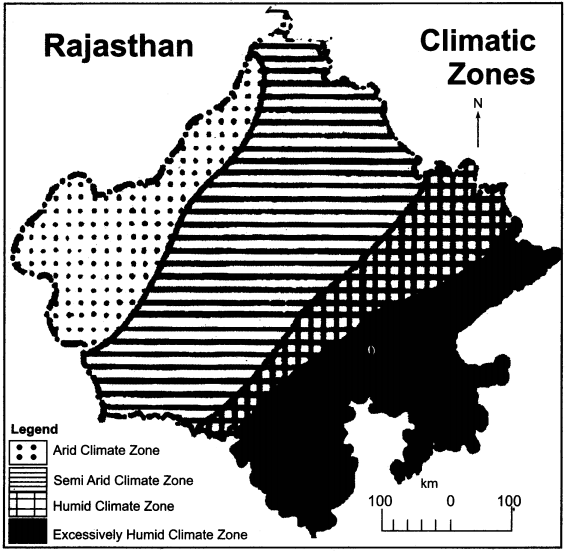
Question 3.
Give a detailed description of forests found in Rajasthan.
Answer:
Variation is seen in the distribution of forests on the basis of geographical regions in Rajasthan. The nature of rainfall is mainly responsible for this variation. Only 9.32 per cent of total area of Rajasthan is covered with forests. The cover of dense forests in Rajasthan is only on 3.83 per cent of the total area of entire state. The forest area in Rajasthan per capita is only 0.03 hectare. The forests found in Rajasthan are classified into the following categories, on the basis of geographical conditions and administration:
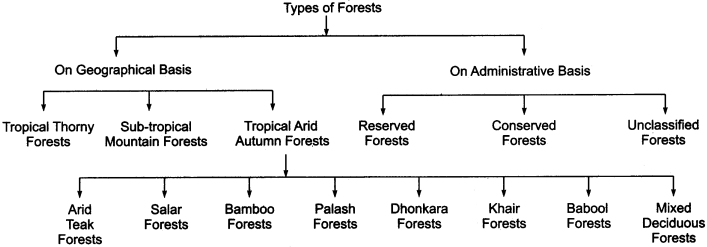
The form of geographical classification in the distribution of forests has been given below:
1. Tropical Thorny Forests:
These types of forests are found in the arid and semi-arid regions of western Rajasthan. Tropical thorny vegetation is found in the districts of Jaisalmer, Barmer, Jodhpur, Pali, Bikaner, Churu, Nagaur, Sikar, Jhunjhunu etc. The tree of Khejri is an important vegetation of this type of forest. Besides it, Ber, Kair, Thor and other shrubs are also found in these forests.
2. Sub – Tropical Mountain Forests:
These forests are found only in the Abu mountainous region. Evergreen and semi – evergreen vegetation is seen in this type of forests. The trees of Mango, Bamboo, Teak and Neem are mainly seen in sub – Tropical mountain forests. These forests are found only in an area of 0.5 per cent.
3. Tropical Arid Autumn Forests:
These forests are extended in a very large area of Rajasthan. These types of forests are found in the central and south – eastern part of Rajasthan where average annual rainfall is from 50 to 100 cm. There are several sub – types of these forest in Rajasthan, i.e. dry teak forests, salar forests, bamboo forests, dhonkara forests, palash forests, babool forests and mixed autumn forests. The forests that are found in the state of Rajasthan have been shown in the following map:
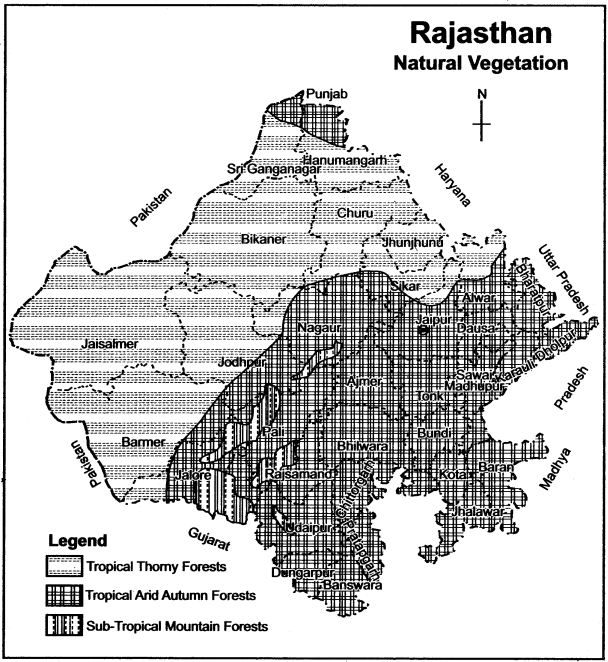
Question 4.
Give a brief description of soils found in Rajasthan.
Answer:
Soil is a natural gift for human beings. The soils play an important role in cultivation of crops and for forests in Rajasthan. The nature of soil seems to be following the geographical variation of Rajasthan. On the basis of colour, composition and fertility, the soils of Rajasthan are classified into:
- Desert soil
- Red – yellow soil
- Laterite soil
- Mixed red and black soil
- Black soil
- Alluvial soil
1. Desert Soil:
It is found in western Rajasthan. The main regions of this type of soil are Jalore, Banner, Jaisalmer, Jodhpur, Bikaner, Churu, Jhunjhunu and Nagaur. It is a less fertile soil. Excessive temperature difference and physical weathering are the chief originating factors of this soil.
2. Red and Yellow soil:
This type of soil is found in the western regions of districts of Sawai Madhopur, Sirohi, Rajsamand, Udaipur and Bhilwara. It is made from the fragmentation of the rocks of granite, gneiss and schist. Red and Yellow soil is rich in ferrous substances, so it gets its yellow – red colour.
3. Laterite soil:
Laterite soil is found in Dungarpur district, central and southern part of Udaipur and southern region of Rajsamand. This type of soil is made by the fragmentation of crystal and metaphoric rocks.
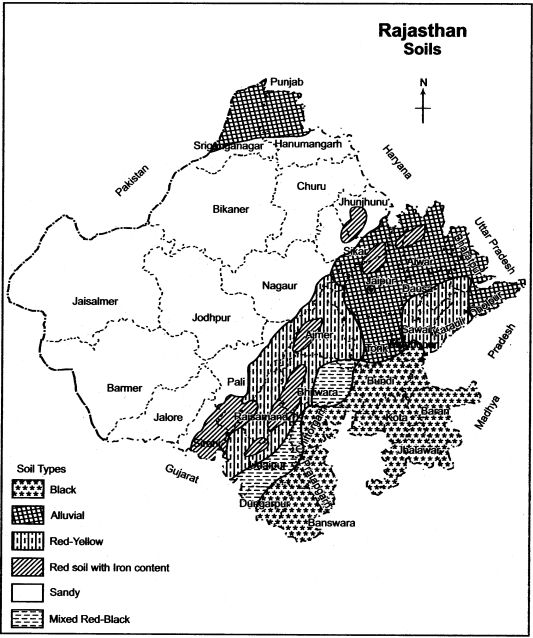
4. Mixed Red and Black Soil:
The distribution of this type of soil is in the districts of Banswara, eastern Udaipur, Dungarpur, Chittorgarh and Bhilwara. It is chika – based soil.
5. Black soil:
Black soil is made of lava and is found in the districts of Kota, Bundi, Baran and Jhalawar. It is alluvial soil rich in chika.
6. Alluvial Soil:
The extension of this soil in Rajasthan is in North-Eastern Ganganagar, Hanumangarh, Alwar, Bharatpur, Dholpur, Karauli, Sawai Madhopur, Dausa, Jaipur and Tonk. It’s colour is light brown and it shows the composition of sandy alluvial.
Map Based Questions
Question 1.
Show the Isotherms in the months of July and January on the map of Rajasthan.
Answer:
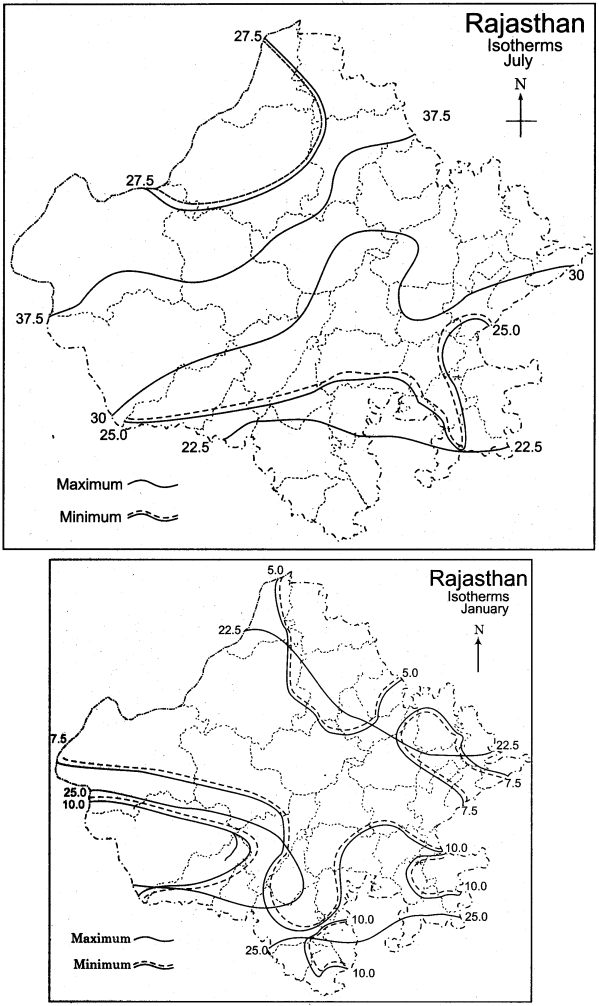
Question 2.
Show the Climate zones of Rajasthan on the map of Rajasthan.
Answer:
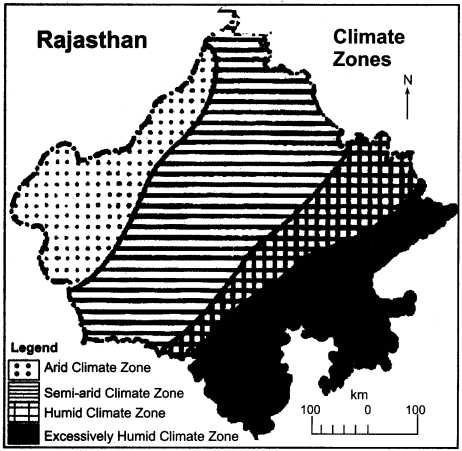
Question 3.
Show the forest areas of Rajasthan on the map.
Answer:
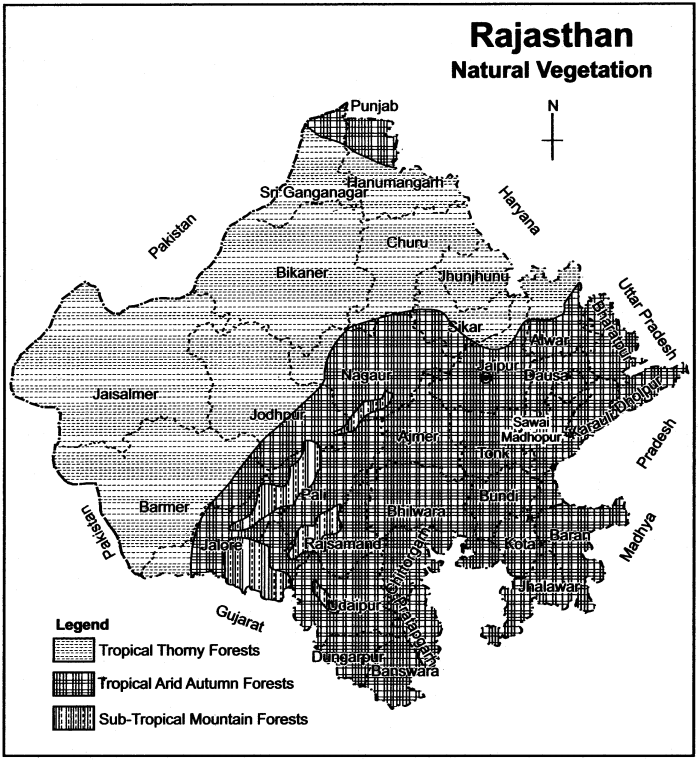
Question 4.
Show the types of soils on the map of Rajasthan.
Answer:
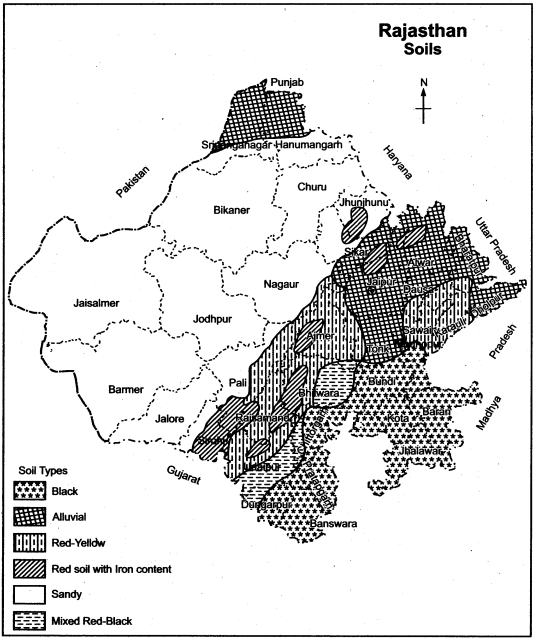
RBSE Class 11 Indian Geography Chapter 13 Other Important Questions
RBSE Class 11 Indian Geography Chapter 13 Multiple Choice Type Questions
Question 1.
Highest range of temperature of Rajasthan is found in:
(a) Western part
(b) Eastern part
(c) Northern part
(d) Southern part
Answer:
(a) Western part
Question 2.
The time period of summer season in Rajasthan is:
(a) March to mid – June
(b) Mid – June to September
(c) October to February
(d) January to March
Answer:
(a) March to mid – June
Question 3.
Loo blows in Rajasthan:
(a) In summer Season
(b) In Winter Season
(c) In Rainy Season
(d) In Autumn Season
Answer:
(a) In summer Season
Question 4.
Monsoon reversal period is called:
(a) Winter season
(b) Summer season
(c) Autumn season
(d) Rainy season
Answer:
(c) Autumn season
Question 5.
Rainfall caused due to moderate cyclones in Rajasthan is called:
(a) Mavath
(b) Mango Showers
(c) Kal Baishakhi
(d) Cherry Blossom Shower
Answer:
(a) Mavath
Question 6.
Highest forest area percentage is found in Rajasthan in
(a) Jaisalmer
(b) Chittorgarh
(c) Jhalawar
(d) Sirohi
Answer:
(d) Sirohi
Question 7.
Kalpavriksha of deserted land is:
(a) Rohira
(b) Khair
(c) Khejari
(d) Dhonkara
Answer:
(c) Khejari
Question 8.
The percentage of conserved forest in Rajasthan is:
(a) 35
(b) 51
(c) 11
(d) 28
Answer:
(b) 51
Question 9.
The ground area in Rajasthan affected from water erosion is:
(a) 2 lakh hectares
(b) 3 lakh hectares
(c) 4 lakh hectares
(d) 5 lakh hectares
Answer:
(c) 4 lakh hectares
Question 10.
How much ground area of Rajasthan is saline and alkaline?
(a) 4.5 lakh hectare
(b) 5.4 lakh hectare
(c) 6 lakh hectare
(d) 7.2 lakh hectare
Answer:
(d) 7.2 lakh hectare
Matching Type Questions
Question A.
Match Column A with Column B:
| Column A (District) | Column B (Climatic zone) |
| (i) Barmer | (a) Excessively humid climate zone |
| (ii) Nagaur | (b) Humid climate zone |
| (iii) Dholpur | (c) Semi – arid climate zone |
| (iv) Dungarpur | (d) Dry climate zone |
Answers:
- (d)
- (c)
- (b)
- (a)
Question B.
Match the trees given in column A with related forests given in Column B:
| Column A (Tree species) | Column B (Related forests) |
| (i) Siris | (a) Palash forests |
| (ii) Kathira | (b) Mixed autumn forests |
| (iii) Kankeri | (c) Dhokara forests |
| (iv) Blackberry | (d) Arid teak forests |
| (v) Adusa | (e) Salar forests |
Answers:
- (d)
- (e)
- (a)
- (b)
- (c)
Question C.
Match the districts given in column A with the type of soil given in Column B:
| Column A (District) | Column B (Type of soil) |
| (i) Jodhpur | (a) Red – Yellow soil |
| (ii) Sirohi | (b) Black soil |
| (iii) Eastern Udaipur | (c) Laterite soil |
| (vi) Kota | (d) Mixed red and black soil |
| (v) Ganganagar | (e) Desert soil |
| (vi) Dungarpur | (f) Alluvial soil |
Answers:
- (e)
- (a)
- (d)
- (b)
- (f)
- (c)
RBSE Class 11 Indian Geography Chapter 13 Very Short Answers Type Questions
Question 1.
What is meant by season?
Answer:
The seasons are the main periods into which an year can be divided and each of which have their own typical weather conditions.
Question 2.
Into how many zones the world has been divided on the basis of temperature?
Answer:
On the basis of temperature, the world has been divided into three zones – Tropical zone, Temperate zone and Frigid zone.
Question 3.
Which are the climatic zones on the basis of rainfall?
Answer:
On the basis of rainfall, the world has been divided into arid climatic zone, semi – arid climatic zone, sub – humid climatic zone, humid climatic zone and excessively humid climatic zone.
Question 4.
Which are the factors that affect the climate of Rajasthan?
Answer:
The factors affecting the climate of Rajasthan include latidudinal position, distance from the sea, height from the sea level, the position and direction of Aravalli mountain range, composition of soil and vegetation coverage.
Question 5.
How many seasons are found in Rajasthan?
Answer:
There are three seasons in Rajasthan:
- Summer season.
- Rainy season.
- Winter season.
Question 6.
What is meant by Loo?
Answer:
The dry, hot and dusty winds that blow during summer season in north-west India are called Loo.
Question 7.
Which line divides Rajasthan into two parts?
Answer:
The 50 cm Isohyet line that is present along the Aravalli divides Rajasthan into two parts.
Question 8.
Why does Rajasthan not receive rainfall from the Arabian Sea Monsoon branch ?
Answer:
The extension of Aravalli mountain range is parallel to the direction of Arabian Sea monsoon branch, so there is no obstruction in monsoon of this branch and hence Rajasthan receives no rainfall from it.
Question 9.
Why does Rajasthan receive very little rainfall from the monsoon of Bay of Bengal branch?
Answer:
The monsoon of Bay of Bengal branch has to cover a long distance before it enters into Rajasthan. Most of precipitation takes place in this long way, so Rajasthan receives very little amount of rainfall from the monsoon of Bay of Bengal branch.
Question 10.
Why is Aravalli mountain range not helpful in causing rainfall?
Answer:
Due to very low height and lack of vegetation cover, Aravalli mountain range is not helpful in causing rainfall.
Question 11.
Into how many parts has the winter season been divided?
Answer:
The winter season has been divided into two parts:
- Autumn or Monsoon Reversal period.
- Dry winter season.
Question 12.
How has Mavath proved to be a boon?
Answer:
The winter rainfall is called Mavath, which is very beneficial for Rabi crops and it increases agricultural produce, so it is a boon for Indian agriculture.
Question 13.
What is meant by freezing point?
Answer:
The temperature at which a liquid (water, water vapour) solidifies, specially, the temperature at which the liquid and solid states of the substance are in equilibrium at atmospheric pressure.
Question 14.
Describe the characteristics of excessively humid climate.
Answer:
The characteristics of excessively humid climate are:
- The average annual rainfall is more than 75 cm.
- The monsoon winds are more active in this area.
- The evergreen forests are found in this type of climate.
Question 15.
What is meant by natural vegetation?
Or
What do you understand by the term natural vegetation?
Answer:
Natural vegetation is the sum total of plant species and the ground cover they provide.
Question 16.
In which districts of Rajasthan there is lack of forests?
Answer:
There is lack of forests in the arid and semi-arid districts-Churu, Nagaur, Jodhpur, Jaisalmer, Barmer etc.
Question 17.
Which type of grass is found in the tropical forest area?
Answer:
The grasses named Sevan and Dhaman are found in the tropical forest area. The grass Dhaman is feeded to milching cattle, while Sevan is useful for all types of animals.
Question 18.
Name the tree species found in the dry teak forests.
Answer:
The main tree species found in the dry teak forests are Tendu, Dhavara, Gurjan, Godal, Siris, Haldu, Khair, Semal, Ritha, Bahera and Tamarind.
Question 19.
Why are teak – trees found only in the southern Rajasthan?
Answer:
The teak trees cannot bear extreme cold and frost, so their extension is mostly found in southern Rajasthan as there is very little cold and frost in this region.
Question 20.
Where are the Salar forests found in Rajasthan?
Answer:
The Salar forests are found mainly in the districts of Udaipur, Sirohi, Chittorgarh, Pali, Ajmer, Jaipur, Alwar and Sikar.
Question 21.
Where are the forests of Dhokara found in Rajasthan?
Answer:
The forests of Dhokara are found in the regions of Rajasthan which are at average height of 240 to 760 m. So, these forests are mainly found in the districts of Kota, Bundi, Sawai MadhopUr, Jaipur, Alwar, Ajmer, Udaipur, Rajsamand and Chittorgarh.
Question 22.
Where are the forests of Palash found in Rajasthan?
Answer:
The forests of Palash are found mainly in the districts of Alwar, Ajmer, Sirohi, Udaipur, Pali, Rajsamand and Chittorgarh in Rajasthan.
Question 23.
Name the species of trees that are found in the mixed deciduous forests.
Answer:
The species of the trees that are found in the mixed deciduous forests are: Aamla, Sheeshem, Salar, Tendu, Amaltash, Rohan, Karanj, Gular and Arjun.
Question 24.
What is the meant by the term reserved forests?
Answer:
A reserved forest is a specific term which is under the direct supervision of the government and there is ban on timber collection or grazing of cattle.
Question 25.
What are unclassified forests?
Answer:
The unclassified forests are those forests where there is no restriction on the cutting of trees and animal grazing.
Question 26.
What is soil?
Or
What is meant by the term soil?
Answer:
The upper most layer of earth in which plants grow, a black or dark – brown material typically consisting of a mixture of organic remains, clay and rock particles.
Question 27.
What are the forming factors of soil?
Or
What are the effecting factors of soil?
Answer:
The forming or controlling or effecting factors of soil are time, climate, parent material, topographical relief and organisms.
Question 28.
Into how many parts are the soils of Rajasthan divided?
Or
What types of soils are found in Rajasthan?
Answer:
On the basis of colour, composition and structure, the soils of Rajasthan have been divided into: Sandy soil, Red – yellow soil, Mixed red and black soil, Laterite soil, Black soil and Alluvial soil.
Question 29.
Where is the Red-yellow soil found in Rajasthan?
Answer:
The red – yellow soil is mainly found in the districts of Sawai Madhopur, Sirohi, Rajsamand, Udaipur and the western part of Bhilwara.
Question 30.
Describe the main characteristics of Laterite soil.
Answer:
The main characteristics of laterite soil are:
- There is a shortage of nitrogen, phosphorous and humus in it.
- Due to presence of ferrous substances, its colour is red.
- The crops of maize, rice and sugarcane are grown in this soil.
- This type of soil is formed by the process of oxidation.
Question 31.
Describe the characteristics of mixed red and black soil.
Answer:
The main characteristics of mixed red – black soil are:
- There is a shortage of calcium, nitrogen, and phosphorous substances in this soil, while potash is in enough amount.
- There is excess of Chika in this soil.
- It is a fertile soil in which crops like cotton, sugarcane, maize, etc. are cultivated.
Question 32.
What is meant by soil erosion?
Or
Explain the term soil erosion.
Or
What is meant by cutting of soil?
Answer:
The process of flowing away or blowing away of the topmost fertile layer of soil in a region due to water or air is called soil erosion. Air-borne soil erosion is found in western part of Rajasthan and water – borne soil erosion is found in the South-eastern plateau part.
Question 33.
What is meant by degradation of soil?
Answer:
Soil degradation is the decline in soil productivity caused by its improper use or poor management, usually for agriculture, industrial or urban purposes. It is a serious environmental problem.
Question 34.
Where are the problems of soil alkalinity and salinity found in Rajasthan?
Answer:
The problems of soil alkalinity and salinity are found in the districts of Alwar, Bharatpur, Jaipur, Nagaur, Pali, Jodhpur, Bhilwara, Chittorgarh and Sirohi. It is a serious problem inJlajasthan.
Question 35.
What is meant by soil conservation?
Or
What is soil reinforcement?
Answer:
Soil conservation is the act of improving the soil strength by performing agriculture in a sensible way, without using such procedures and substances which cause decline in the quality of soil. This process of conservation helps to retain the balance in soil fertility.
RBSE Class 11 Indian Geography Chapter 13 Short Answer Type Questions (SA-I)
Question 1.
What type of variation is seen in the climate of Rajasthan?
Or
There is regional variation in the climate of Rajasthan. How? Explain.
Answer:
The climate of Rajasthan shows variation because of its large geographical area and regional disparity found in the factors which determine the climate. Rajasthan is located in the north western part of India, and thus, it is more prone to different climatic changes, while the western part of Rajasthan is dry and infertile, the south – western part is hilly and wet.
The climate of Rajasthan varies throughout the state. In the desert areas, it is usually hot and dry in summer and cold in winter. Towards the Aravalli range, to the west, both rainfall and humidity are low. While towards the east, weather is characterized by greater humidity and more rainfall. In short, the climate of Rajasthan is dry – sub – tropical monsoon type.
Question 2.
Write the characteristics of summer season of Rajasthan.
Or
Which physical conditions are depicted by the summer season of Rajasthan? Explain.
Answer:
The following specific conditions during summer season are seen in Rajasthan:
- The arrival of summer season in Rajasthan starts with the northward movement of the sun.
- The temperature rises up in most of the regions.
- It is terribly hot during the day.
- The hot and dry winds start blowing which are called as Loo.
- The hot and dusty storms is a very common phenomena in summer.
- There is lack of humidity in air.
- It is pleasant during the night.
Question 3.
Describe the rainy season of Rajasthan.
Answer:
The characteristics of rainy season in Rajasthan are:
- Rajasthan receives rainfall from both the monsoon branches.
- There is an uneven distribution of rainfall in Rajasthan. It keeps on decreasing from east to west and from south to north.
- Most of the rainfall of Rajasthan occurs during the rainy season.
- There is very little annual rainfall in the state even after the presence of both the branches of monsoon.
Question 4.
Describe the winter season of Rajasthan.
Or
Which types of characteristics does the winter season show in Rajasthan? Explain.
Answer:
- The arrival of winter season in Rajasthan starts along with the declination of sun toward the south.
- The North – Western cold winds start blowing in the entire state.
- Sometimes, the temperature falls down to freezing point in some parts of the state.
- Frost takes place in some regions during the winter.
- It rains due to temperate cyclones in the winter which is called as Mavath in local language.
Question 5.
The Mavath is a boon for Rajasthan. Why?
Or
Describe the importance of Mavath for Rajasthan.
Answer:
Mavath is winter rainfall in Rajasthan caused by western disturbance which is a tropical storm originating from the Mediterranean Sea region that brings sudden rainfall in Western Rajasthan. The Mavath or precipitation during the winter season has great importance in agriculture, particularly for the Rabi crops. Wheat among them is one of the most important crops, which helps to fulfill the food requirement of Rajasthan as well. And, hence, Mavath serves as a boon for Rajasthan.
Question 6.
Describe the importance of natural vegetation.
Or
What is the utility of forests for Rajasthan?
Answer:
The importance of forests for Rajasthan:
- Forests play an important role in maintaining the environmental and ecological balance.
- Forests make the local climate pleasant and balanced.
- Forests make the flow of rivers regular.
- Forests provide raw materials for various industries.
- Forests help to check soil erosion.
- Forests provide employment to people.
- Forests help to check the intensity of storms.
- Forests provide wood, timber, fodder for cattle, herbs and medicines and other valuable products.
- Forests are the natural habitat for wildlife.
Question 7.
Describe the characteristics of tropical thorny forests.
Or
Describe the peculiarities of the tropical forests.
Answer:
The chief characteristics of tropical thorny forests are:
- The size of the trees of tropical forests is very short.
- Mainly, there are only shrubs found in these forests.
- The length of the roots of the trees of these type of forests is too long to absorb the humidity from the depth of ground.
- The leaves of the trees are narrow and thorny.
- Abundance of grasses is seen in these forests which are very useful for milching animals.
- The leaves of these trees are smaller and round – shaped.
Question 8.
Describe the characteristics of the forests of Dhonkara.
Answer:
The main characteristics of Dhonkara forests are:
- Except the desert region, the geographical and environmental conditions of Rajasthan are favorable for this trees forests.
- The extension of these forests is on most part of Rajasthan.
- These types of forests are found at a height of 240 meters to 760 meters from sea level.
- These forests have been included under the state property.
- The wood obtained from these forests is quite solid and strong.
- This wood is burnt to obtain charcoal.
- Along with Dhonkara, Palash trees are also found in the foothill regions of the mountains.
Question 9.
Explain the process of soil formation.
Or
The formation of soil is a result of many factors. How? Explain.
Answer:
Soil is the thin layer of material covering the earth’s surface and is formed from the weathering of rocks. It is made up mainly of mineral particles, organic materials, air, water and living organisms, all of which interact slowly and constantly. The process by which soil is formed as a result of interaction overtime between parent material (rock) climate, topography and organisms is known as pedogenesis. .
Question 10.
Explain the characteristics of Desert soil.
Or
The desert soils are known for their unique structure. How? Explain.
Answer:
The desert soils are found in unfavorable climatic zones of western Rajasthan. Their main characteristics are given below:
- The formation of this type of soil is due to physical fragmentation (temperature and wind).
- It is transformed mainly by the winds.
- The water holding capacity of this soil is very low.
- There is very low amount of fertile elements, while a lot of salinity is present in this soil.
- The structure of this soil is seen in two forms sandy soil and concrete soil.
- It proves to be fertile, if there are enough facilities of irrigation.
Question 11.
Describe the characteristics of red – yellow soil.
Answer:
The main characteristics of red – yellow soil are:
- This soils lacks in fertile elements.
- It is formed by the fragmentation of the rocks like granite, schist and Gneiss.
- It lacks in elements like calcium and nitrogen.
- It is rich in ferrous substances, so it is in red colour.
- Mt is suitable for the cultivation of cotton and groundnut.
Question 12.
Explain the problem of soil erosion in Rajasthan.
Answer:
Soil erosion is a serious problem in Rajasthan. The process of soil erosion is performed by the physical factors like water and air. Due to this, the cutting of soil depicts the forms of gully erosion or sheet erosion. About 4 lack hectare of land in Rajasthan is effected by erosion caused by water. The erosion due to water is seen in the drainage areas of the rivers Chambal and its tributaries.
Water – borne soil – erosion is mainly seen in the districts of Kota, Sawai Madhopur and Dholpur. Wind – borne soil erosion is mostly seen in the deserted areas of Western Rajasthan. The dry hot and violently blowing winds have shallowed up thousand of hectares of fertile land of Rajasthan.
RBSE Class 11 Indian Geography Chapter 13 Short Answer Type Questions (SA-II)
Question 1.
How does the temperature of Rajasthan show variation during the month of July? Explain.
Or
Explain the condition of isotherms during the month of July.
Answer:
In Rajasthan, the condition of temperature found in the month of July shows variations. The isotherms which show temperature in Rajasthan depict the maximum and minimum temperature regions. In the districts of western Rajasthan, mainly Jaisalmer, Bikaner, Shri Ganganagar, western parts of Jodhpur, Hanumangarh and western Churu, average temperature is more than 37.5°C to 50°C.
On the other hand, maximum average temperature of around 25° C to 37.5°C is found in Barmer, South – eastern part of Jaisalmer, central part of Jodhpur, Nagaur, South – Eastern regions of Churu, Jhunjhunu, Sikar, Alwar, Bharatpur, Dausa, Karauli, Dholpur and Sawai Madhopur, and in Bikaner, South – Western part of Ganganagar, western part of Churu, the average temperature remains around 27.5°C.
In the districts of Jalore, North – western part of Sirohi, North – Eastern region of Pali, Banswara, Ajmer, Jaipur, Bundi, Kota, Baran and Chittorgarh and northern Jhalawar, the average maximum temperature is seen to be between 32.5°C and 35°C, while average minimum temperature is about 25°C. The maximum average temperature in the districts of Udaipur, Dungarpur, Banswara, most of Chittorgarh, Southern regions of Rajsamand is 32.5°C. The average minimum temperature in the same districts is below 25°C.
Question 2.
Describe the distribution of forests in Rajasthan.
Answer:
Conditions found in Rajasthan show variations due to its vast geographical area. The geographical conditions and climate of Rajasthan is of such type, that the extension of forests in this state is significantly less as compared to the other states of India.
According to the National Forest Policy (1988), in order to conserve the ecological system, there should be forests on at least one-third part of the total surface area. In Rajasthan, there are forests on only 9.32% of surface area. Dense forest region amounts only to 3.83% in Rajasthan. Per capita forest area in Rajasthan is just 0.03 hectare, which is significantly less than the average per capita forest area of 0.13 hectare of entire India. There is significant variation in the geographical distribution of forests in Rajasthan.
Relatively denser forest regions of Rajasthan are present in the districts of Sirohi, Banswara, Dungarpur, Udaipur, Rajsamand, Chittorgarh, Jhalawar, Kota, Bundi, Sawai Madhopur and Alwar. Forests are present on more than 20% area of these districts. Churu, Nagaur, Jodhpur, Jaisalmer and Barmer districts situated in the dry region of Rajasthan have forests on less than 2% of their total geographical surface area.
In Rajasthan, Sirohi and Churu are districts with maximum (31%) andjninimum (0.05%) forest cover respectively. Only thorny bushes and Sevan grass is found in Jaisalmer. Due to the provision .of water from the Indira Gandhi Canal, greenery is now on an increase.
Question 3.
While moving from the west towards the east in Rajasthan, the natural vegetation pattern changes. Why? Explain it.
Answer:
The vegetation of Rajasthan follows its physical zones. On moving from west to east, the conditions of temperature, amount of rainfall and structure of soil also change at large. There is desert in the western part of Rajasthan in which arid and semi-arid vegetation is found due to high temperature, lack of rainfall and sandy soil.
The mountain vegetation is seen in the Aravalli range, while in the eastern plains of Rajasthan, the dense deciduous forests are seen due to the network of rivers, sufficient rainfall and fertile alluvial soil. On the other hand, there is excess humidity in the hilly regions of Mount Abu and hence dense evergreen forests are seen in this hilly area.
The types of forests change along with the amount of rainfall and temperature. As the amount of rainfall is increased, the dry and deciduous forests transform into evergreen forests. While moving from South to North and East to West, the form of forests keeps on changing into smaller and rarer.
Question 4.
Explain the administrative classification of forests in Rajasthan.
Answer:
On the basis of administration, the forests of Rajasthan have been divided into three categories:
1. Reserved forests:
A reserved forest is a specific term for designating such forests and other natural areas, which enjoy judicial and/or constitutional protection under the legal law code of Rajasthan. These forests are included in national property in which animal grazing and wood-cutting is prohibited. These forests play an important role in checking flood, soil erosion and extension of desert.
2. Conserved forests:
These forests are also under the control of government. Animal grazing and wood – cutting and gathering forest produce is permitted after following and fulfilling various rules and regulations.
3. Unclassified forests:
The Government has no control over these types of forests. Wood – cutting and animal grazing can be practiced in these forests. 11 per cent of total forest area of Rajasthan is included under these type of forests.
Question 5.
Describe the benefits obtained from the forests in the state.
Answer:
A brief description of benefits derived from the forests in the state is as given below:
- We obtain timber, wood and bamboo from the forests.
- Forests provide us various forest products such as honey, wax, catechu, gum etc. that fulfill many of our daily needs.
- We obtain Tendu – leaves which are used as raw material in Bidi Industry. Besides it, the cups (Dona) and plates (Pattal) are made from the leaves of Palash.
- We obtain many types of fruits like mango, blackberry, mulberry, gooseberry, pumpkin, cranberry, khirni, custard apple etc.
- Forests provide us incense grasses which are used for making the essential oils and perfumes.
- We obtain many type of herbs that are used to make Ayurvedic medicines.
- Sericulture is practiced on the trees of mulberry and castor to obtain silk.
- The forests provide us raw materials for several industries such as paper, match stick, sports goods, rubber, paint, etc.
- Forests provide fodder for our cattle.
Question 6.
Describe the indirect benefits derived from forests.
Or
What are the invisible long-term benefits of the forests found in Rajasthan?
Answer:
There are various invisible and long-term benefits of forests, which are obtained after a long time period. These benefits are called indirect benefits of forests. Some of invisible benefits are given as below:
- The forests play an important role in keeping environment even and moist.
- The forests attract the clouds and thus cause rainfall.
- The forests reduce the intensity of storms and cyclones.
- The forests reduce the outbreak of floods.
- The forests are helpful in checking the soil erosion and expansion of deserts.
- The leaves of trees get mixed up in the soil and provide humus and thus increase the fertility of soil.
- The forests absorb the rain water and in this way they increase the ground water level.
- The burned forests turn into coal due to earth’s extreme pressure and temperature which is a main source of energy.
- Forest provide a natural habitat for wildlife.
- Forests are the junctions for sport and so they provide entertainment to people.
- Forests are very beautiful and charming and are therefore called the Ornaments of our Earth.
- Forests are helpful in maintaining the ecological balance.
- By releasing oxygen, forests reduce environmental pollution.
- Forests reduce noise pollution.
- Forests control the greenhouse gas effect caused by air pollution.
- Forests have an important place in Indian culture and civilization. They are considered the most suitable places for contemplation and meditation and worshiping Gods.
Question 7.
Compare Black and Alluvial soil found in Rajasthan.
Or
How are Black and Alluvial soils different from each other?
Answer:
The difference between Black and Alluvial soils of Rajasthan can be clarified on the basis of the following points:
| Basis of Comparison | Black soil | Alluvial soil |
| Colour of soil | It is black in colour. | It is light – brown or red in colour. |
| Composition | It is chika – rich alluvial soil. | It is sand – based alluvial soil. |
| Substances present | In this soil, calcium and potash are found. | There is enough quantity of limestone, phosphorous, potash and iron content in this soil. |
| Crops cultivated | The main crops cultivated are rice, sugarcane, coriander and soybean. | The main crops cultivated are wheat, mustard, cotton and tobacco. |
| Areas | It is found in the districts of Kota, Bundi, Baran and Jhalawar. | This type of soil is found in Ganganagar, Hanumangarh, Alwar, Jaipur, Dausa, Dholpur, Karauli, Tonk and Sawai Madhopur. |
Question 8.
What steps should be taken to maintain the fertility of soil?
Or
How can the quality and fertility of soil be retained?
Answer:
To maintain the quality and fertility of soil, the following steps should be taken:
- The overflow of water causes the problem of water logging, due to which the fertile elements of soil are washed out. Hence, excessive water flow must be controlled.
- To control the salinity of soil, the crops like barley, cotton, maize etc. should be cultivated.
- To retain the nitrogen in the soil, pulse crops such as gram, kidney bean, etc. should be cultivated periodically.
- The use of fertilizers, chemicals, pesticides and germicides must be minimized in agriculture, and green manure, compost and bio-manure should be used.
- The soils must be examined in laboratories from time to time.
- Minerals such as gypsum, calcium should be mixed into the soil, if required.
RBSE Class 11 Indian Geography Chapter 13 Essay Type Questions
Question 1.
Explain the distribution of rainfall in Rajasthan.
Or
The distribution of rainfall in Rajasthan shows inequalities. How ? Explain.
Answer:
Rajasthan is a state of vast geographical area. Due to this large area, there are inequalities in annual rainfall seen all over Rajasthan. These inequalities of rainfall are on regional level. Due to internal conditions of Rajasthan, there is very little rainfall in the state. In the eastern parts of Aravalli range, there is sufficient annual rainfall. But in the western part of Aravalli range, rainfall is very less. On the basis of rainfall in the state, Rajasthan has been divided into 5 zones:
1. Regions with more than 100 cm rainfall:
In these regions of Rajasthan, the annual average rainfall is found to be more than 100 cm. In this category, districts such as Sirohi, (Mount Abu), western Udaipur, Rajsamand, south-western Bhilwara etc. are included.
2. Regions with 75 to 100 cm rainfall:
The annual average rainfall is from 75 to 100 cm in these regions. The districts of Jhalawar, southern Kota, eastern part of Chittorgarh, Pratapgarh, Banswara, Dungarpur (western part), central region of Udaipur, central .and southern Bhilwara, eastern regions of Sirohi and Pali and central part of Rajsamand are included in this zone.
3. Regions with 50 to 75 cm rainfall:
In this zone, the districts such as south – eastern and eastern areas of Jalore, central Pali, Ajmer, Jaipur, Dausa, Alwar, Bharatpur, Dholpur, Karauli, Sawai Madhopur, Tonk, Bundi, Baran, Kota and Bhilwara are included.
4. Regions with 25 to 50 cm rainfall:
The average annual rainfall between 25 cm to 50 cm is seen in the districts of Jhunjhunu, Sikar, Nagaur, Jodhpur, (western part), most parts of Jalore, Pali, Ajmer, and westerm parts of Jaipur.
5. Regions with less than 25 cm rainfall:
Under this category, the districts of Sri Ganganagar, Hanumangarh, Bikaner, Jaisalmer, Phalodi Tehsil of Jodhpur, Barmer and western regions of Nagaur are included.
The distribution of rainfall in the state of Rajasthan is shown in the map given below:
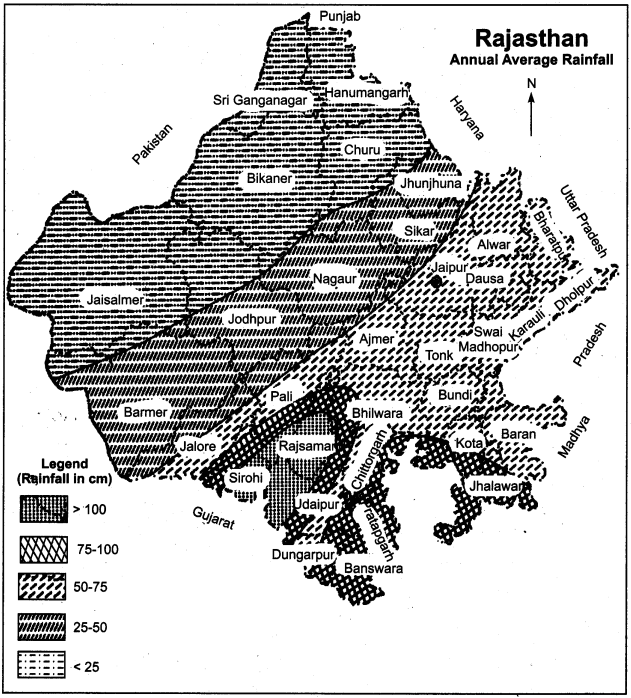
Question 2.
What do you understand by the term soil conservation ? State the methods soil conservation.
Answer:
Meaning of soil conservation: Soil conservation is the prevention of soil loss from erosion, or reduced fertility caused by over-usage, acidification, salinization or other chemical soil contamination. Slash and burn and other unsustainable methods of subsistence farming are practiced in some lesser developed areas which reduce soil fertility.
Methods of Soil Conservation:
The major methods for soil conservation used worldwide are:
1. Practice of Contour Ploughing:
Contour ploughing involves planting crops following the contour of the landscape rather than planting crops in straight vertical rows. This orients crop furrows to follow the contour lines, thus reducing water run-off during rain storms.
2. Practice of Terrace Farming:
Terrace farming is almost similar to contour farming. It uses the land topography to establish a series of terraces to reduce water run-off during rain storms. It involves the practice of creating closely – leveled areas in a hillside area, like a series of steps with each step placed at a higher level than the previous one.
3. Practicing Organic Farming:
Organic farming is exclusively reliant on green manure, compost, biological pest control, and crop rotation to produce crops, livestock and poultry.
4. Embankment:
To reduce the slopes of field, the boundary wall should be made a little bit high so that the run-off of water at the time of rain storms may be checked.
5. Cover Crops or Crop Rotation:
Crop rotation is the systematic planting of different crops in a particular order over several years to maintain the nutrients in the soil, reduce soil erosion and prevent plant diseases and pests,
6. Afforestation:
Afforestation provides an extensive tree root network that offers a long-term solution for soil erosion and so it is the best method for soil conservation. It also helps in increasing the water absorption capacity of soil.
7. Controlled Grazing:
Controlled grazing over the pastures is helpful in soil conversation because due to this the grass gets enough time to develop again.
8. Construction of Ponds and Dams:
Construction of small ponds at suitable places to store excess water is a good practice to raise the ground water level, while the dams are capable to store the overflowing water of rivers and so they can help in reducing soil erosion.
9. Other Methods:
For soil conservation, other methods such as dry farming, field strip cropping, mulching, basin listing, sub – soiling, gully control etc. can also be practiced.